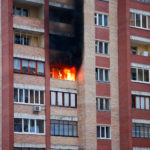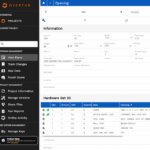When readers of iDigHardware hear of a door-related tragedy, many will send me links to news stories, social media discussions, and other information about the incident. I feel honored to have a job and a voice that allow me to make a difference, and I’m grateful to have connections who believe that I can help.
Yesterday I received dozens of emails, texts, and Facebook messages about the apartment fire that occurred in the Bronx yesterday morning. At least 17 people – including 8 children* – were killed in the fire, with many more critically injured. As with past fires, the NYFD Commissioner highlighted the open apartment door during his press conference. From the New York Times:
Commissioner Nigro said the fire started in a bedroom on the third floor where a space heater was being used. Once the fire spread in that apartment, individuals ran out and left the door open, which helped fuel the fire and allowed the smoke to spread. “We’ve spread the word, ‘close the door, close the door’” to keep a fire contained, he said.
There will be more information to come regarding what happened during this fire and how it affected the loss of life, the severity of injuries, and the property damage. I will share that when I have it. For now, a few thoughts…
1) Self-closing apartment doors have been required by the US model codes for decades. In the 1948 edition of NFPA 101 – Life Safety Code, a chapter addressing “apartment houses” was added. This section required apartment buildings meeting certain criteria to have fire doors on the apartment entries and stairwells. Fire doors are required to be self-closing, automatic-closing, or power-operated, with very few exceptions, to ensure that the door is closed and latched during a fire. In the 1973 edition of NFPA 101, a line was added to the code which specifically stated that apartment entry doors were required to be self-closing. This requirement was not limited to certain types of apartment buildings, it applied to all buildings that met the definition of an apartment building:
2) New York City Local Law 111 requires all apartment entry doors to be self-closing. This law was passed after a 2017 fire in the Bronx, which killed 13 people and injured 14, and the deadline for compliance was July 31, 2021:
§ 28-315.10 Self-closing doors. All doors providing access to interior corridors or stairs in occupancy groups R-1 and R-2 shall be self-closing or equipped with a device that will ensure closing after having been opened by July 31, 2021.
In addition, the law amended the administrative code of NYC, establishing responsibility for maintaining the doors, and consequences for failure to do so:
§ 27-2041.1 Self-closing doors.
a. It shall be the duty of the owner of a multiple dwelling, which is required to be equipped with self-closing doors pursuant to section 28-315.10, or any other applicable law, to keep and maintain such doors in good repair.
b. Any owner required to keep and maintain self-closing doors pursuant to subdivision a of this section who fails to keep or maintain such doors shall be liable for a class C immediately hazardous violation. Notwithstanding any other provision of law to the contrary, the time within which to correct such violation shall be twenty-one days after service of the notice of violation.
In Sunday’s fire, we don’t know (yet) why the door didn’t close. Was the door self-closing but something obstructed it and prevented it from closing when residents escaped? Had the self-closing device been deactivated or damaged? Or was the door non-compliant with building codes, fire codes, and NYC Local Law 111?
3) Stairwell fire doors play an extremely important role in fire safety and egress. In the Bronx fire, several victims of the fire were found in the stairwells. The New York Times article states:
Commissioner Nigro said the building did not have fire escapes, only interior stairways, leaving the residents with only a short window to flee as smoke made its way throughout the building.
In a building of this height, current codes would require the interior stairwell doors to provide at least 90 minutes of fire protection, along with 2-hour walls enclosing the stairwell. If the fire doors were closed and latched, building occupants should have had time to enter the protected area of the stairwell, and make their way to the ground floor or wait for assistance from the fire department. I have not seen mention of whether the stairway doors were open or closed at the time of the fire, but open stairwell doors could help to explain the rapid spread of smoke and the compromised egress routes.
4) Fire door assembly inspections are required by code, after installation, after maintenance work, and annually. These requirements were added to the codes and standards because of the appalling condition of millions of fire doors across the U.S. Annual inspections help to ensure that a fire door will perform as designed and tested if there is a fire. Without the inspections, who knows?
While some jurisdictions are enforcing the annual fire door assembly inspection requirements, some are not. Why not? These inspections, typically conducted by 3rd-party inspectors trained in fire door requirements, document the condition of existing fire doors. Needed repairs must be completed “without delay” and can be confirmed by the AHJ upon review of the documentation. This is an incredibly valuable tool for AHJs when evaluating the fire safety of a building.
I will be focusing this week’s posts on this topic…we owe it to the residents of Twin Parks North West and all other apartment residents. This is not the first fire of this type, nor will it be the last.
If you have questions or comments, or more information about this fire, please share them in the box below.
Photo: David Dee Delgado for The New York Times
*The number of fatalities was modified by the medical examiner on January 10, 2022.
You need to login or register to bookmark/favorite this content.











Not sure why I keep reading
“. It was at a building that was built under federal guidelines way back when, so it’s not up to New York City fire codes,” said Andrew Ansbro, president of the the FDNY Uniformed Firefighters Association union “”
Federal Guidelines??
Exactly! And does that mean that it should not have to comply with Local Law 111???
– Lori
I’ve lived in NYC for many years and so many old apartment buildings here are not fully sprinklered, do not have a full fire alarm system, and rely on fire rated construction and doors to keep people safe in a fire. Never once have I had an apartment door inspected, or heard of anyone else getting their doors inspected.
I’d love to see the city make rated door inspections a mandatory reporting requirement, similar to the required facade inspections they instituted for masonry buildings after several injuries and fatalities from falling masonry.
I hope so too, Alanna. I honestly don’t know why there isn’t complete enforcement of the fire door inspection requirements.
– Lori
Simple effective and should be repeated often
https://www.youtube.com/watch?v=1PNSapiTshI
In Massachusetts, the building code, through it’s referenced standards mandates fire door inspections as you have pointed out in this article. When I became the Building Commissioner several years ago, I pursued this requirement and was met with significant resistance from building owners with the question “Is this something new?” “Nobody ever made us do this before.” Enforcement requires diligent follow-up and persistence which in turn requires adequate staffing and training of building and fire officials. I fear that these types of preventable tragedies will continue to occur in spite of codes written and intended to prevent them. It is an uphill battle to get people to understand that when nothing bad happens it’s usually because someone has done their job enforcing the codes.
Hi Jeffrey –
Thanks so much for sharing your insight! At one point (years ago), the MA BBRS stated that they did not require fire door inspections, even though the edition of NFPA 80 referenced by the code at that time did require annual inspections. I just checked the current Mass Fire Code, and the section in NFPA 1 that requires fire door inspections was NOT deleted. So I guess the answer to building owners is that it’s not new, and it’s required by code. Failure to do the annual inspections could result in major liability if there is a fire and the doors are not code-compliant. For new buildings and renovations, it’s in the best interest of the building owner that the doors are inspected, so they know that they are getting code-compliant fire doors from the start. That way any problems are corrected by the contractor before the building is turned over.
It seems like it would be really helpful if the state building commissioner and state fire marshal would put out a document that local code officials could use when objections are raised by building owners. What do you think?
– Lori
I think one picture generally distributed can probably be worth thousands of articles. The one that comes to my mind is that of an outline in black soot on white bedsheets from a fire that killed that young girl. The outline of her hair was reality itself. The photos you have posted from time to time showing the two sides of a fire or smoke door – one death and destruction and the other side safe and untouched should be periodically shown every time there is a fire like this one. Somehow this must be driven home.
Hi Jerry –
I have not seen that particular photo, but I am going to put together an information sheet for people who may not have a background in codes or doors, and I have some great photos that I will use to illustrate the value of a closed and latched fire door.
– Lori
A piece on one of the channels said the doors were inspected in July of 21. It will be interesting to see who gets the blame (my guess is it will not be the resident). If I was a reporter, would have folks test every door in the city.
Virtually all of these disasters follows some kind of event chain. Heating does not work so buy a space heater; don’t have the outlet space so get a plug strip; don’t supervise the kiddos and he moves the heater around and causes an ignition; occupants bail out and door does not close; fire starts and smoke accumulates into the hall; stair doors don’t close, so the escape route is blocked and smoke enters the other floors; fire alarm has long gone off but residents say it goes off all the time so they don’t pay attention. loosing precious minutes. and on and on.
… for want of a nail the war was lost….
Exactly.
– Lori
Melange Restoration Inc. can assist you with all steps to the Local Law 11 filing and repair process, ensuring that your building remains up to code and that any necessary repairs are made swiftly and at minimal inconvenience to you or your tenants.
While I am all for fire safety/prevention, self closing hinges, to protect other residents in my building, what has been left out is that the conversations between handicapped residents that use mobility devices, more specifically wheelchair users, have not taken place to find a solution to the self-closing hinge problem. Accessibility devices are NOT being installed in apartments, at least not in my building, to alleviate this issue of every day life. Wheelchair users say that their apartments now feel like a prison because they cannot come and go if they need to and when they try their mobility devices are being damaged by these doors closing on them as they try to enter or leave on a daily basis. Are these property owners/managers going to pay for repairs or buy everyone new mobility devices every time they are beyond repair due to this damage? This, of course, is if these residents can even open the door in the first place to get their mobility device in the doorway.
These doors can be especially dangerous for seniors as well. I watched as a 96 years old resident struggled to open one of these doors and then it swung back so quickly that she was flung clear across the hallway into the opposite wall. She could’ve gotten a concussion or worse broken bones like her hip.
Any loss of life during a tragedy like a fire is inexcusable when it can be prevented, but they are making mobility device users sitting ducks during a fire, whether it’s to the fire itself or smoke inhalation. And it’s not like they can ask other residents, who are trying to escape with their own lives, to hold their doors open during a fire so that they can exit the building too.
As a wheelchair user myself, I’ve been fighting for months with state and government officials to at least be heard about these concerns and start the conversation to come up with a solution to this problem. I have been met with resistance at every turn even though they know this fire regulation violates the ADA by not installing the accessibility devices! I finally got a meeting with a man yesterday, who is supposed to be listening to my concerns so we could come up with a solutions together, and all he did was cut me off every time I tried to speak. If they don’t want to have a conversation to fix the problems/concerns or install accessibility devices, then they need to relocate the residents that have trouble with these doors to single floor buildings that don’t require the self-closing hinges, at the property owner’s expense. There are so many other solutions I can think of, but without a conversation with people who are willing to compromise, think outside the box, and find solutions, this is just going to escalate.
P.S. I am sorry about the long response on an old post.
Hi Tanya –
Thanks so much for sharing your insight! I agree, this is an issue. BUT – the products to help with this problem are readily available. We just need to find a way to encourage building owners and property managers to invest in these solutions.
– Lori